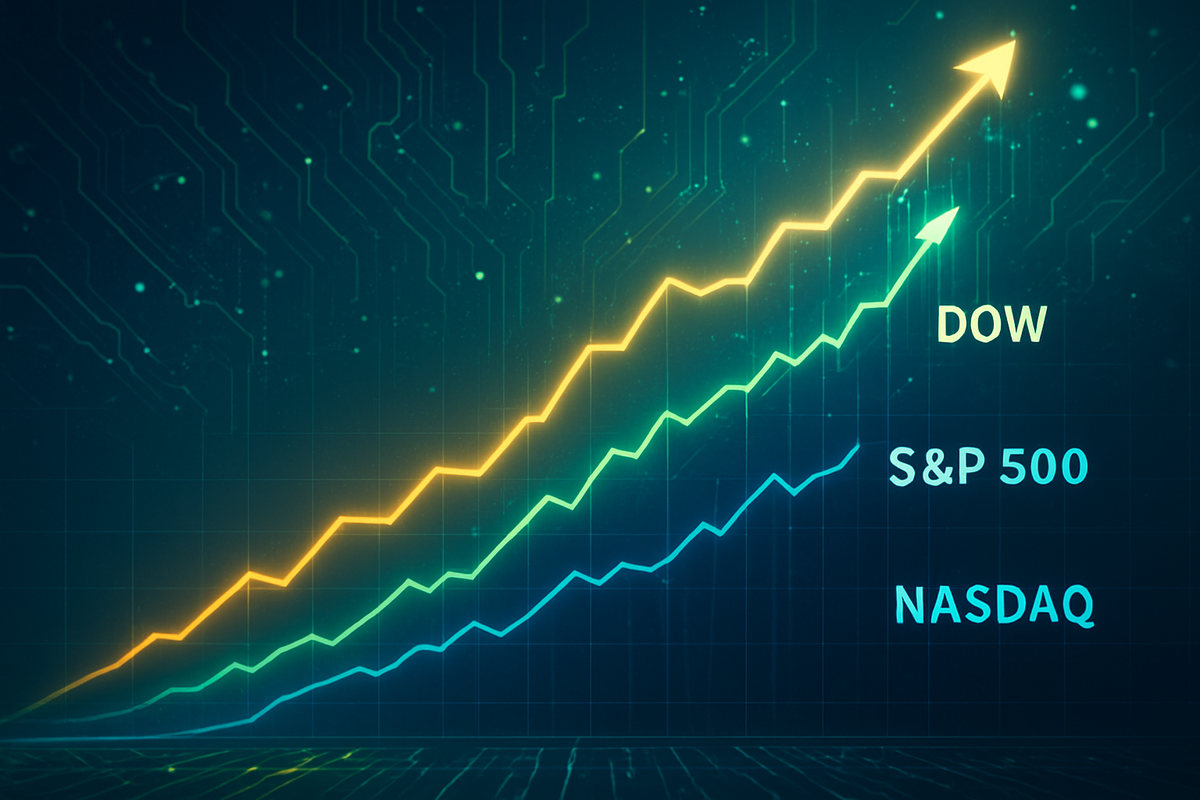
October 2025 has cemented its place in financial history, witnessing the Dow Jones Industrial Average (DJIA), S&P 500, and Nasdaq Composite simultaneously shatter all-time highs. This synchronized surge, sustained over multiple consecutive trading sessions, paints a picture of robust investor confidence and an undeniably bullish market sentiment. The immediate implication is a "risk-on" environment, with capital flowing freely into equities, driven by a potent cocktail of strong corporate earnings, optimism surrounding global trade, and the promise of continued accommodative monetary policy from the Federal Reserve.
However, beneath the celebratory headlines, a closer look reveals a market heavily concentrated in specific high-growth sectors, particularly technology and artificial intelligence (AI). While the record-breaking spree is exhilarating for investors, it also sparks critical questions about the breadth and sustainability of this rally, especially given elevated valuations and underlying economic signals that suggest a more nuanced reality. The market now stands at a pivotal juncture, balancing unprecedented gains with the inherent anxieties of an extended bull run.
A Historic Ascent: The October 2025 Market Phenomenon
The closing days of October 2025 have been nothing short of extraordinary for the U.S. stock market. As of October 29, all three major indices – the Dow, S&P 500, and Nasdaq – have not only reached but repeatedly surpassed new all-time highs, a feat that underscores the current market's formidable momentum. This historic rally saw the indices setting intraday records for a fourth straight session on October 29, following three consecutive days of record closes.
The Dow Jones Industrial Average (DJIA), a barometer for blue-chip stocks, closed at 47,706.37 on October 28, marking a 0.3% gain, and continued its ascent with another 0.4% increase on October 29. This trajectory follows its initial breach of the 40,000 mark in May 2024, demonstrating sustained upward pressure. The S&P 500 (SPX) also posted impressive gains, rising 0.2% to 6,890.89 on October 28, and adding another 0.2% on October 29. This marked its 36th record close of the year by October 29, delivering an impressive 18.33% return over the past year and surpassing 6,850 points on October 27. Meanwhile, the technology-heavy Nasdaq Composite (IXIC) surged 0.8% to 23,827.49 on October 28, with a further 0.5% gain on October 29, underscoring the dominant role of the tech sector in this rally.
Several key factors have converged to fuel this unprecedented run. A significant driver has been robust corporate earnings, with roughly one-third of S&P 500 companies reporting and an impressive 83% beating forecasts. Notably, companies in the technology and artificial intelligence (AI) sectors, such as United Parcel Service (NYSE: UPS) and PayPal Holdings (NASDAQ: PYPL), have delivered particularly strong results. The "AI Gold Rush" has been a primary catalyst, with the Information Technology sector leading the market with over 20% year-to-date gains in 2025. This momentum culminated in a historic moment on October 29 when Nvidia (NASDAQ: NVDA), a pivotal player in AI, achieved a staggering $5 trillion market capitalization, becoming the first company to reach this milestone.
Adding to the bullish sentiment are expectations of continued accommodative monetary policy from the Federal Reserve. The market widely anticipates a 25-basis-point interest rate cut on October 29, marking the second such reduction this year, bringing the target range to 3.75% to 4%. This easing of monetary conditions is seen as highly supportive of market liquidity and growth. Furthermore, renewed optimism surrounding a potential breakthrough in U.S.-China trade relations, with a highly anticipated meeting between President Trump and Chinese leader Xi Jinping, has further bolstered investor confidence, clearing a path for reduced geopolitical uncertainty.
Winners and Losers in a Soaring Market
The current bull run, while lifting all major indices, is not creating uniform benefits across the board. The primary beneficiaries are undoubtedly the technology and artificial intelligence (AI) giants, which have been the undisputed leaders of this rally. Companies like Nvidia (NASDAQ: NVDA), which recently hit a staggering $5 trillion market capitalization, are at the forefront of the "AI Gold Rush." Other key players in semiconductors, cloud computing, and software, such as Microsoft (NASDAQ: MSFT), Alphabet (NASDAQ: GOOGL), and Amazon (NASDAQ: AMZN), are experiencing massive capital inflows and robust growth. Their strong earnings reports, coupled with the immense future potential of AI, continue to attract significant investor interest, driving their stock prices to new heights and disproportionately contributing to the overall market's ascent.
Beyond the tech sector, companies with strong balance sheets and consistent earnings growth are also thriving. Large-cap companies across various sectors, particularly those with global reach and diversified revenue streams, tend to perform well in a "risk-on" environment. Financial institutions, though benefiting from overall market optimism, might face a nuanced impact from anticipated interest rate cuts, which could narrow their net interest margins. However, increased market activity and deal-making could offset some of these pressures. Consumer discretionary companies, buoyed by strong consumer confidence and a healthy job market, are also seeing positive momentum, though their sensitivity to economic shifts makes their long-term outlook more volatile.
Conversely, the concentration of gains in a few mega-cap technology stocks raises concerns about market breadth and leaves some sectors and companies lagging. Value stocks, which have historically underperformed growth stocks during periods of rapid technological innovation, might continue to struggle to keep pace with the broader market's ascent. Companies that are highly sensitive to rising input costs or those operating in mature, slow-growth industries might find it challenging to justify higher valuations, especially if their earnings growth doesn't match the market's enthusiasm. Furthermore, smaller-cap companies, while potentially offering higher growth in specific niches, often receive less attention from investors during periods when large-cap tech dominates headlines, leading to a widening performance gap.
The potential for a "recessionary signal" highlighted in the Fed's Beige Book also casts a shadow over companies that are highly cyclical or heavily dependent on consumer spending. While the current environment is optimistic, any downturn could disproportionately affect these businesses. Moreover, companies with high debt loads could face increased scrutiny if borrowing costs, despite current rate cut expectations, were to unexpectedly rise or if credit markets tighten. The current market, while broadly positive, is creating a distinct divergence between the high-flying tech innovators and more traditional, slower-growth enterprises, making strategic positioning crucial for investors.
Wider Significance: Navigating a Shifting Economic Landscape
The current market rally, marked by the Dow, S&P 500, and Nasdaq reaching unprecedented highs, is more than just a fleeting moment of exuberance; it signifies a deeper recalibration of economic expectations and technological influence. This event fits squarely into broader industry trends emphasizing digital transformation, artificial intelligence integration, and the increasing dominance of technology companies in global commerce. The "AI Gold Rush" is not merely a sectoral boom but a fundamental shift, with AI's pervasive applications promising to redefine productivity, innovation, and competitive advantage across nearly every industry. This trend suggests that companies failing to adapt and integrate AI into their operations risk being left behind, creating a widening chasm between tech-forward innovators and traditional businesses.
The ripple effects of this bull run are profound, impacting competitors and partners alike. For competitors, especially those in traditional sectors, the pressure to innovate and demonstrate clear growth pathways intensifies. Companies that are direct competitors to the tech giants, or those whose business models are threatened by technological disruption, face an uphill battle. Conversely, partners and suppliers to the booming tech sector, such as semiconductor manufacturers, cloud infrastructure providers, and specialized software developers, stand to benefit immensely from increased demand and investment. The regulatory landscape is also evolving in response to the growing power of tech behemoths; discussions around antitrust, data privacy, and market concentration are likely to intensify, potentially leading to new policies that could temper the growth of these dominant players or create new compliance challenges.
Historically, periods of concentrated market leadership, particularly by a single sector, have often preceded periods of market correction or rotation. The dot-com bubble of the late 1990s serves as a cautionary tale, where excessive valuation and speculation in internet stocks led to a dramatic bust. While the current AI boom is underpinned by more tangible technological advancements and corporate profitability, the S&P 500's Shiller PE ratio at 41, combined with the fact that its ten largest companies constitute over 40% of the index, evokes historical parallels that demand careful consideration. This concentration raises questions about market health and resilience, suggesting that while the momentum could continue, the risk of a sharp correction, particularly if earnings disappoint or economic sentiment shifts, is elevated.
Furthermore, the Federal Reserve's anticipated interest rate cuts and the potential end of quantitative tightening signal a move towards more accommodative monetary policy, which typically supports asset prices. However, the dual narrative of strong market performance alongside some recessionary signals from the Fed's Beige Book creates a complex picture. This suggests that while liquidity may improve, underlying economic vulnerabilities could persist, requiring investors to discern between market-driven enthusiasm and fundamental economic strength. The wider significance lies in understanding whether this bull run is a sustainable, broad-based economic expansion or a concentrated surge driven by specific technological waves and monetary policy, with potential long-term implications for market structure and stability.
What Comes Next: Navigating the Future of the Bull Market
Looking ahead, the immediate future of this bull market appears to be a delicate balance between sustained momentum and growing caution. In the short term, the prevailing "risk-on" sentiment, coupled with strong corporate earnings expectations and the Federal Reserve's accommodative stance, suggests that the market could continue its upward trajectory. The historical precedent of the S&P 500 often gaining an average of 2.2% in the three months following simultaneous record highs across major indices further supports this outlook. Investors will likely continue to favor high-growth technology and AI stocks, driving further capital into these sectors. However, this also means that market breadth might remain narrow, with the performance of a few mega-cap companies dictating overall index movements.
In the long term, the sustainability of this bull run hinges on several critical factors. Continued innovation and adoption of AI technologies will be paramount, translating technological advancements into tangible productivity gains and broader economic growth. Companies will need to strategically pivot, focusing on integrating AI into their core operations to maintain competitiveness and unlock new revenue streams. This will require significant investment in R&D, talent acquisition, and infrastructure. Market opportunities will emerge in ancillary services supporting the AI ecosystem, such as specialized data centers, cybersecurity, and ethical AI development. Conversely, challenges include potential regulatory headwinds, increased scrutiny over market concentration, and the risk of a "tech bubble" if valuations detach too far from fundamentals.
Potential strategic adaptations for investors and companies will involve a more nuanced approach to portfolio management. Diversification beyond the dominant tech sector will become increasingly important to mitigate risks associated with concentrated gains. Companies outside the immediate AI sphere will need to find ways to leverage AI to enhance their own operations, rather than simply competing with the tech giants head-on. This could involve strategic partnerships, targeted acquisitions, or internal innovation initiatives to integrate AI into existing business models.
Several scenarios could unfold. In an optimistic scenario, AI development continues to accelerate, driving unprecedented productivity growth across industries, leading to a sustained and broad-based economic expansion that justifies current valuations. In a more cautious scenario, regulatory actions or an unexpected economic downturn could trigger a significant market correction, particularly affecting overvalued tech stocks. Another possibility is a market rotation, where capital flows out of high-flying growth stocks and into undervalued sectors or international markets, leading to a rebalancing of market leadership. Investors should closely monitor corporate earnings reports for signs of slowing growth, inflation data, and any shifts in the Federal Reserve's monetary policy rhetoric, as these will be crucial indicators for navigating the evolving market landscape.
The Unfolding Narrative: A Market at a Crossroads
October 2025 will be remembered as a landmark month, where the Dow, S&P 500, and Nasdaq Composite etched new all-time highs into the financial records. The key takeaways from this historic period are the undeniable strength of the "AI Gold Rush," the robust performance of corporate earnings, and the supportive backdrop of anticipated accommodative monetary policy. This confluence of factors has fueled a "risk-on" environment, propelling investor confidence to elevated levels. However, the rally's concentrated nature, heavily reliant on a handful of mega-cap technology and AI companies, along with elevated valuations and subtle recessionary signals, presents a complex narrative.
Moving forward, the market stands at a crossroads. While the immediate momentum suggests continued gains, particularly within the dominant tech sector, the long-term sustainability of this bull run is subject to rigorous scrutiny. The market's future trajectory will largely depend on the ability of AI innovation to translate into broader economic productivity, the judicious management of monetary policy by the Federal Reserve, and the absence of unforeseen geopolitical or economic shocks. Investors should prepare for potential volatility and a possible rebalancing of market leadership as the implications of AI become more widespread and regulatory landscapes evolve.
Ultimately, the significance of this event extends beyond mere stock price movements; it reflects a transformative era driven by technological advancement. The lasting impact will be seen in how industries adapt to AI, how regulatory bodies respond to market concentration, and how investors navigate a landscape where unprecedented growth coexists with inherent risks. What investors should watch for in the coming months are not just headline index figures, but also the breadth of market participation, the actual implementation of AI across diverse sectors, and any shifts in the Federal Reserve's forward guidance. A discerning eye will be crucial to distinguish between genuine, sustainable growth and speculative exuberance in this dynamic market.
This content is intended for informational purposes only and is not financial advice





